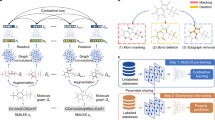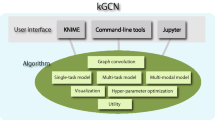Abstract
Molecular “fingerprints” encoding structural information are the workhorse of cheminformatics and machine learning in drug discovery applications. However, fingerprint representations necessarily emphasize particular aspects of the molecular structure while ignoring others, rather than allowing the model to make data-driven decisions. We describe molecular graph convolutions, a machine learning architecture for learning from undirected graphs, specifically small molecules. Graph convolutions use a simple encoding of the molecular graph—atoms, bonds, distances, etc.—which allows the model to take greater advantage of information in the graph structure. Although graph convolutions do not outperform all fingerprint-based methods, they (along with other graph-based methods) represent a new paradigm in ligand-based virtual screening with exciting opportunities for future improvement.











Similar content being viewed by others
References
Abadi M, Agarwal A, Barham P, Brevdo E, Chen Z, Citro C, Corrado GS, Davis A, Dean J, Devin M et al (2015) TensorFlow: large-scale machine learning on heterogeneous systems. Software. http://tensorflow.org
Ballester PJ, Richards WG (2007) Ultrafast shape recognition to search compound databases for similar molecular shapes. J Comput Chem 28(10):1711–1723
Bruna J, Zaremba W, Szlam A, LeCun Y (2013) Spectral networks and locally connected networks on graphs. arXiv:1312.6203
Carhart RE, Smith DH, Venkataraghavan R (1985) Atom pairs as molecular features in structure-activity studies: definition and applications. J Chem Inf Comput Sci 25(2):64–73
Dahl G (2012) Deep learning how I did it: Merck 1st place interview.http://blog.kaggle.com/2012/11/01/deep-learning-how-i-did-it-merck-1st-place-interview
Dahl GE, Jaitly N, Salakhutdinov R (2014) Multi-task neural networks for QSAR predictions. arXiv:1406.1231
Dieleman S (2015) Classifying plankton with deep neural networks. 17 Mar 2015. http://benanne.github.io/2015/03/17/plankton.html
Duchi J, Hazan E, Singer Y (2011) Adaptive subgradient methods for online learning and stochastic optimization. J Mach Learn Res 12:2121–2159
Duvenaud DK, Maclaurin D, Iparraguirre J, Bombarell R, Hirzel T, Aspuru-Guzik A, Adams RP (2015) Convolutional networks on graphs for learning molecular fingerprints. In: Advances in neural information processing systems, pp 2224–2232
Gasteiger J, Marsili M (1980) Iterative partial equalization of orbital electronegativity–a rapid access to atomic charges. Tetrahedron 36(22):3219–3228
Hawkins PCD, Skillman AG, Nicholls A (2007) Comparison of shape-matching and docking as virtual screening tools. J Med Chem 50(1):74–82
Ioffe S, Szegedy C (2015) Batch normalization: accelerating deep network training by reducing internal covariate shift. arXiv:1502.03167
Jain AN, Nicholls A (2008) Recommendations for evaluation of computational methods. J Comput Aided Mol Des 22(3–4):133–139
Landrum G (2014) RDKit: open-source cheminformatics. http://www.rdkit.org
LeCun Y, Bengio Y, Hinton G (2015) Deep learning. Nature 521(7553):436–444
Lusci A, Pollastri G, Baldi P (2013) Deep architectures and deep learning in chemoinformatics: the prediction of aqueous solubility for drug-like molecules. J Chem Inf Model 53(7):1563–1575
Ma J, Sheridan RP, Liaw A, Dahl GE, Svetnik V (2015) Deep neural nets as a method for quantitative structure–activity relationships. J Chem Inf Model 55(2):263–274
Masci J, Boscaini D, Bronstein M, Vandergheynst P (2015) Geodesic convolutional neural networks on riemannian manifolds. In: Proceedings of the IEEE international conference on computer vision workshops, pp 37–45
Mayr A, Klambauer G, Unterthiner T, Hochreiter S (2015) Deeptox: toxicity prediction using deep learning. Front Environ Sci 3:80
McGill R, Tukey JW, Larsen WA (1978) Variations of box plots. Am Stat 32(1):12–16
Merkwirth C, Lengauer T (2005) Automatic generation of complementary descriptors with molecular graph networks. J Chem Inf Model 45(5):1159–1168
Micheli A (2009) Neural network for graphs: a contextual constructive approach. IEEE Trans Neural Netw 20(3):498–511
Muchmore SW, Souers AJ, Akritopoulou-Zanze I (2006) The use of three-dimensional shape and electrostatic similarity searching in the identification of a melanin-concentrating hormone receptor 1 antagonist. Chem Biol Drug Des 67(2):174–176
Mysinger MM, Carchia M, Irwin JJ, Shoichet BK (2012) Directory of useful decoys, enhanced (DUD-E): better ligands and decoys for better benchmarking. J Med Chem 55(14):6582–6594
Nicholls A, McGaughey GB, Sheridan RP, Good AC, Warren G, Mathieu M, Muchmore SW, Brown SP, Grant JA, Haigh JA et al (2010) Molecular shape and medicinal chemistry: a perspective. J Med Chem 53(10):3862–3886
OpenEye GraphSim Toolkit. OpenEye Scientific Software, Santa Fe, NM. http://www.eyesopen.com
Pedregosa F, Varoquaux G, Gramfort A, Michel V, Thirion B, Grisel O, Blondel M, Prettenhofer P, Weiss R, Dubourg V et al (2011) Scikit-learn: machine learning in python. J Mach Learn Res 12:2825–2830
Petrone PM, Simms B, Nigsch F, Lounkine E, Kutchukian P, Cornett A, Deng Z, Davies JW, Jenkins JL, Glick M (2012) Rethinking molecular similarity: comparing compounds on the basis of biological activity. ACS Chem Biol 7(8):1399–1409
Ramsundar B, Kearnes S, Riley P, Webster D, Konerding D, Pande V (2015) Massively multitask networks for drug discovery. arXiv:1502.02072
Rogers D, Hahn M (2010) Extended-connectivity fingerprints. J Chem Inf Model 50(5):742–754
Rohrer SG, Baumann K (2009) Maximum unbiased validation (MUV) data sets for virtual screening based on pubchem bioactivity data. J Chem Inf Model 49(2):169–184
Rumelhart DE, Hinton GE, Williams RJ (1986) Learning representations by back-propagating errors. Nature 323:533–536
Scarselli F, Gori M, Tsoi AC, Hagenbuchner M, Monfardini G (2009) The graph neural network model. IEEE Trans Neural Netw 20(1):61–80
Seabold S, Perktold J (2010) Statsmodels: econometric and statistical modeling with python. In: Proceedings of the 9th Python in science conference, pp 57–61
Srivastava N, Hinton G, Krizhevsky A, Sutskever I, Salakhutdinov R (2014) Dropout: a simple way to prevent neural networks from overfitting. J Mach Learn Res 15(1):1929–1958
Swamidass JS, Azencott C-A, Lin T-W, Gramajo H, Tsai S-C, Baldi P (2009) Influence relevance voting: an accurate and interpretable virtual high throughput screening method. J Chem Inf Model 49(4):756–766
Szegedy C, Liu W, Jia Y, Sermanet P, Reed S, Anguelov D, Erhan D, Vanhoucke V, Rabinovich A (2015) Going deeper with convolutions. In: CVPR 2015. arxiv.org/abs/1409.4842
Todeschini R, Consonni V (2009) Molecular descriptors for chemoinformatics, volume 41 (2 volume set), vol 41. Wiley, New York
Truchon J-F, Bayly CI (2007) Evaluating virtual screening methods: good and bad metrics metrics for the âĂIJearly recognitionâĂİ problem. J Chem Inf Model 47(2):488–508
Wallach I, Dzamba M, Heifets A (2015) AtomNet: a deep convolutional neural network for bioactivity prediction in structure-based drug discovery. arXiv:1510.02855
Yanli W, Xiao J, Suzek TO, Zhang J, Wang J, Zhou Z, Han L, Karapetyan K, Dracheva S, Shoemaker BA et al (2012) PubChem’s BioAssay database. Nucl Acids Res 40(D1):D400–D412
Zadeh LA (1965) Fuzzy sets. Inf Control 8(3):338–353
Acknowledgments
We thank Bharath Ramsundar, Brian Goldman, and Robert McGibbon for helpful discussion. We also acknowledge Manjunath Kudlur, Derek Murray, and Rajat Monga for assistance with TensorFlow. S.K. was supported by internships at Google Inc. and Vertex Pharmaceuticals Inc. Additionally, we acknowledge use of the Stanford BioX3 cluster supported by NIH S10 Shared Instrumentation Grant 1S10RR02664701. S.K. and V.P. also acknowledge support from from NIH 5U19AI109662-02.
Author information
Authors and Affiliations
Corresponding author
Electronic supplementary material
Below is the link to the electronic supplementary material.
Rights and permissions
About this article
Cite this article
Kearnes, S., McCloskey, K., Berndl, M. et al. Molecular graph convolutions: moving beyond fingerprints. J Comput Aided Mol Des 30, 595–608 (2016). https://doi.org/10.1007/s10822-016-9938-8
Received:
Accepted:
Published:
Issue Date:
DOI: https://doi.org/10.1007/s10822-016-9938-8




